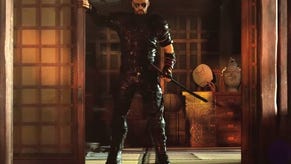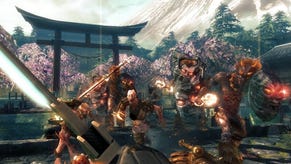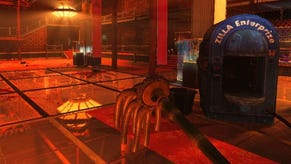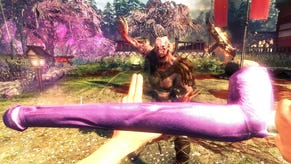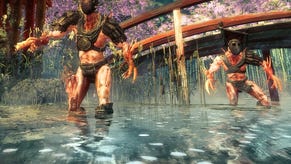Shadow Warrior review
Can Lo Wang keep us entertained? Shuriken.
There are a lot of things I like about Shadow Warrior, Flying Wild Hog's modern reimagining of 3D Realms' ageing, racially insensitive first-person shooter, but I think the thing I like most is the level design, which is pure 90s. Remember key cards? Pulling levers to lower water levels? Magically sealed doors? It's all here. Each chapter is a labyrinthine sprawl of arenas, locked doors and secret areas. If you ever looked at the top-down map of a Doom level and marvelled at its intricacies, you will probably enjoy Shadow Warrior.
Actually, you will probably enjoy it anyway, because even if this cartographical nostalgia isn't doing it for you, there's plenty more to like, if not admire. Shadow Warrior is a game of simple pleasures - bad jokes, gorgeous graphics, florid decapitations - and as long as you don't expect too much from it, you are unlikely to be disappointed.
It begins in style. The game's star may have inherited his dumb name from 3D Realms, but this Lo Wang is immediately likable as you meet him speeding along a forest highway singing along to "You Got The Touch" by Stan Bush. Then his phone rings. "You got Wang." We discover he's on his way to buy an ancient sword called the Nobitsura Kage for his employer, Orochi Zilla, and if it's not for sale then he's to obtain it anyway.
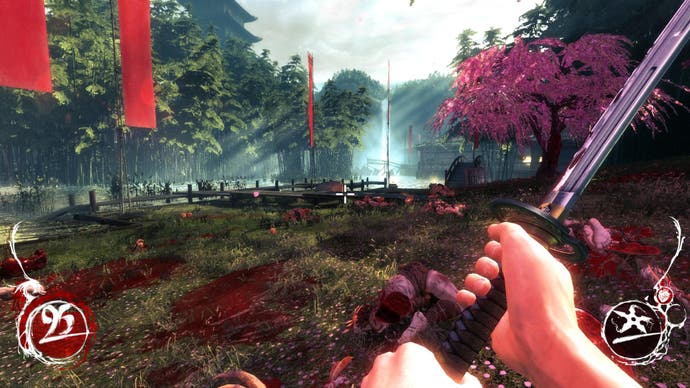
Once he arrives at his destination, an enormous Japanese residence in the countryside, Wang is quickly set upon by the sword owner's bodyguards. What follows is a tutorial, I guess, but it's so comically violent that you spend more of it laughing than learning as Wang wheels around carving off arms, legs and heads with his katana. Even so, he's quickly captured, and it's only when demons attack that he is able to escape, falling into a love-hate alliance with a masked demon called Hoji, who accompanies him on his adventure.
Wang has to fight his way out of the compound, ducking in and out of traditional wooden buildings, through cherry orchards, bamboo forests and other open locations, battling monsters, poking around for collectables and ammo pickups, investing upgrade points and cracking wise with Hoji. Things get a lot more heated later on as you work your way through towns, temples, docks, underground tunnels and an icy fortress, but the pattern of swapping from mild exploration to bloodthirsty combat and back is quickly established. It's all divertingly old-fashioned and the developer's homespun graphics engine is a treat, doing particularly beautiful things with light, shadow, blossom and terracotta.
Shadow Warrior is happy to play up its dumb action game heritage in the panic and violence of its combat and its occasionally pubescent outlook - this seems the best way to categorise the pixelated, half-naked anime girls you find hidden in secret rooms, an element of the original game that adds little in its new context, not to mention the pervy latex outfits given to a pair of female assassins. But it's not as dumb as it sometimes pretends. Take the story, as mostly told through exchanges between Wang and Hoji, who sounds a bit like Heath Ledger's Joker.
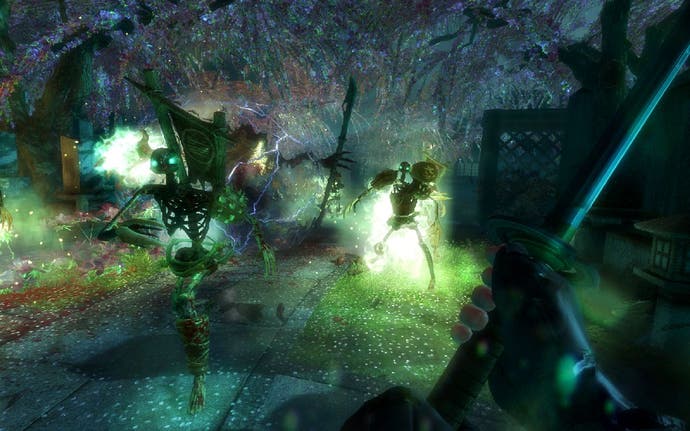
Hoji explains that the demons have arrived from the Shadow Realm and the only way to save the world - and for Hoji to return home - is to hunt down the Nobitsura Kage, which is much more than just a pretty old sword. So your quest sends you in search of 'whisperers', magical golems containing memories, through which you learn that the Shadow Realm has been starved of the rain brought by the tears of Hoji's sister, Ameonna, who has been poisoned and left in a trance, and whom its rulers now wish to revive. All of which ought to be way too much story for a game which is ostensibly about backing away from hordes of demons firing a shotgun, but Flying Wild Hog plays it straight and with great affection, filling in the background in beautiful painted flashback panels and forbidding narration.
It's all rather unexpected, given the game's origins. The first Shadow Warrior occasionally came across like Mickey Rooney in Breakfast at Tiffany's in its attempts to wring humour out of the developer's love of bad kung fu movies. But, while Flying Wild Hog knows Lo Wang is a walking punchline, the jokes at his expense in the modern game are about his character rather than his racial background, while other stabs at humour that employ cultural stereotypes are harmless and fairly successful, like jokes found in discarded fortune cookies. ("The early bird gets the worm," says one. "The second mouse gets the cheese.") This Shadow Warrior's cultural appropriation is more sensible, then, and generally used to fuel the elaborate mythology more than anything else. OK, the story is still trite, but at least you end up fighting an ancient god who takes the form of a giant flying horse.
The combat is also smarter than it perhaps appears. Years of forced walks, experience points and 'cinematic tutorial trenches', for want of a better phrase, make it easy to forget that first-person shooters used to have radically different priorities, but Shadow Warrior hasn't forgotten. Movement is smooth and ridiculously fast, you quickly amass a sizable arsenal with no restrictions on what you can bring into battle, and enemies are thrown at you in vast tides that only subside once some unseen director decides you've had enough.
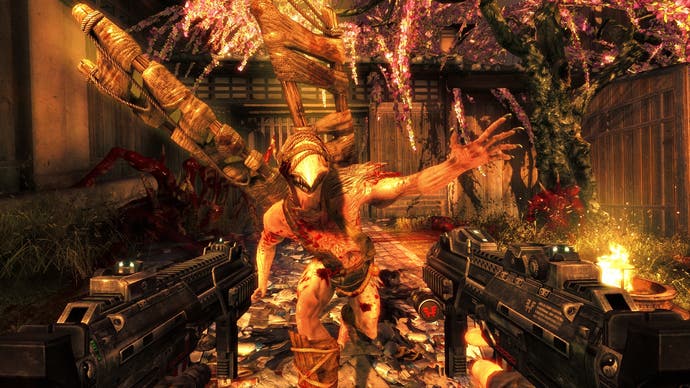
That probably looks enjoyable enough through rose-tinted spectacles, but the fact Shadow Warrior remains interesting once the nostalgia wears off is down to a few smart elements. One is your versatile dash move, which allows you to dart in and prioritise targets with lethal speed and precision, before evading attacks and escaping the throng as you move out to plan your next move. Another is the arena design, which always blossoms out into interesting spaces that give you room to manoeuvre despite the huge numbers of enemies you face simultaneously. Another still is your "Ki" abilities, particularly the healing move, which means regenerating your health is about dancing out of range and performing a frantic button combo rather than looking for cover that does not exist.
The best element, though, is also the simplest: Shadow Warrior has excellent weapons. The pistol is meaty enough, but once you get your hands on shotguns, Uzis, rocket launchers and crossbows and start unlocking their upgrades and alternative fire modes, turning to the weapon wheel isn't about checking whether you've got enough ammo for that one gun you like, it's about pulling up a menu and struggling to choose between dishes. Add two more barrels and faster reloading to the stubby shotgun and it absolutely mulches enemies, while you can measure your progress taking down hardier demons by counting the crossbow bolts sticking out of their heads. Let's not forget that katana, either, which is always there if you fancy a change of pace and becomes increasingly powerful as you progress.
Shadow Warrior doesn't get everything quite right, though. Not unlike the games of its ancestor's heyday, levels often drag on beyond their optimum runtime or don't offer enough architectural variation to stop you getting confused and losing track of where you're going. Enemy designs are also hit and miss. The rank-and-file are engaging fodder - individually weak but powerful as a swarm - and the bosses are surprisingly entertaining, but flying harpy enemies and toxic balls that chase you around and explode when you get too close to them? They could have left that stuff back in 1997.
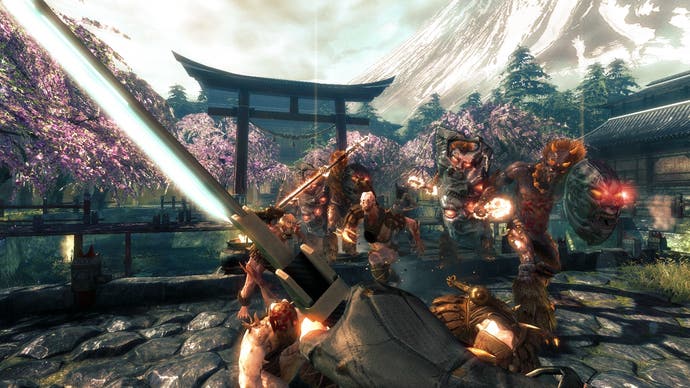
And for all its successes, Shadow Warrior is also limited by its very specific ambition to be a throwback to older shooters. In the years since the original Shadow Warrior, games like Half-Life and Halo have done things with first-person storytelling and enemy behaviour that set a new baseline for quality, but this modern reimagining has little interest in those advances. It taps expertly into our memories of frantic battles, sprawling levels, scattered secrets and regular humour, but it doesn't strive to go much beyond that, merely taking an archetypal 90s shooter and iterating on it using modern technology as though nothing else has happened.
As a smarter-than-it-looks nostalgia trip, then, Shadow Warrior delivers, and as long as you keep that in mind - and consume it in moderation - it's an easy recommendation.


